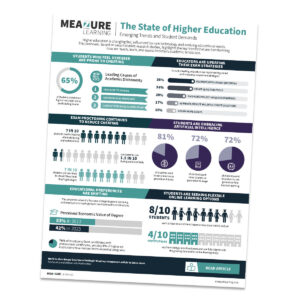As a companion piece to our data-driven infographic, this article explores the key themes, challenges, and opportunities in higher education today. Drawing from multiple research reports, the article presents the latest and most significant findings about how we teach, learn, and assess in the postsecondary world.
Let’s dive in to these key themes and explore what they mean for students, educators, institutions, and solution providers.
Theme #1: Student Stress and Academic Dishonesty Are Related
For many higher-ed students, stress is a palpable challenge. In fact, 65% report significant stress during exams.1 The intense strain that students face in academic settings is not just about the exams themselves; it’s exacerbated by heavy workloads, the pressure to do well, and the feeling that some course content isn’t relevant or practical.
This high-stress environment can push students toward academic dishonesty. And that’s troubling because it suggests that cheating is not always the result of a premeditated, morally lax decision but sometimes a response to immense academic pressure. Further compounding the issue is the belief among students that a significant percentage (ranging from 26%2 to 90%3) of their peers are cheating. When students think that academic misconduct is common and perhaps even necessary to stay competitive, it can create a culture where dishonesty is normalized and, in some ways, rationalized. This can lead to a concept called “moral disengagement,” where students disconnect from their sense of right vs. wrong in response to environmental pressures.
These interconnected factors—high stress, the temptation of academic dishonesty, perceptions of widespread cheating, and moral disengagement—create a problematic cycle in higher education. And it not only affects academic integrity but also impacts students’ moral and ethical development. In response, institutions need to examine their educational environment, the pressures placed on their students, and the support systems they offer.
Theme #2: Educators Are Updating Their Exam Strategies
To curb cheating, many educators are implementing varied and innovative assessment strategies.4 Of these educators:
- 36% are using more open-ended questions,
- 34% are creating larger question pools,
- 28% are giving more project-based assignments,
- 17% are eliminating or reducing multiple-choice questions, and
- 15% are assigning more essays.
By updating their exam strategies, postsecondary educators are moving away from traditional, one-dimensional testing methods, which tend to rely on rote memorization. Instead, they’re prioritizing more secure and authentic evaluations that better prepare students for the real world—and the complexities of the modern workforce.
Theme #3: Exam Proctoring Continues to Reduce Cheating

Over the past few years, exam proctoring has further cemented its status as a significant deterrent to cheating.5 A recent study on academic integrity shows a stark difference in exam misconduct rates, with 70% of students exhibiting dishonest behavior during unproctored exams and only 15% exhibiting similar behavior during proctored exams.6 The fear of getting caught is a crucial factor in these rates. According to a survey by Wiley, about 73% of students claim they’re less likely to cheat if there’s a risk of getting caught.7
These findings aren’t tied to a particular exam delivery modality either. Around 90% of higher-ed instructors reported that between 1% and 20% of their students were caught cheating during in-person classes, hybrid classes, and online classes.8 This finding by Wiley suggests that misconduct attempts occur at the same rate across all modalities.
Our own proprietary data supports this conclusion. Of more than 800,000 higher-ed students who took a live-proctored exam in 2023, 73% tried to use unpermitted materials and 13% required active intervention. Only a small portion of these scenarios resulted in an approved integrity report from our team citing a legitimate suspicion of cheating. That’s because—in many cases—the students weren’t actively trying to circumvent exam rules. That said, around 3% of these students were reported for an integrity incident. When paired with the statistics about misconduct rates across modalities, however, a clear conclusion emerges: Supervision—not modality—is what influences integrity the most.
Theme #4: Students Are Seeking Flexible Online Options
Online learning and testing are here to stay. A recent survey reports that an overwhelming 82% of students prefer at least partial online learning and 41% favor a fully online experience.9 Yet, institutions face challenges in meeting these expectations, with only 40% of online officers saying their strategic priorities and resources are fully aligned with the growing demand for online learning today.10
It’s important to consider the connection—and sometimes disconnection—between students’ preference for online learning and their concerns about data privacy. A report by New America and the National Association of Student Personnel Administrators reveals good news: Students generally trust their institutions to handle their data appropriately. However, that trust declines as third-party companies—including proctoring providers—are added to the mix. In response to this finding, the report advises institutions to “reduce the number of third-party proctoring companies with which students must interact and should be clear about what data they are collecting.”11
It’s worth noting that the report recommends decreasing—not eliminating—the number of third-party proctoring companies. A key advantage of using a single proctoring provider is its potential to alleviate privacy worries while ensuring academic integrity. As concerns about data privacy and ethical use continue to evolve throughout the student body, building trust and awareness will hinge on more transparent data practices and communication methods.
Theme #5: Educational Values Are Shifting

The perceived value of a traditional four-year college degree has steadily declined—from 53% in 2013 to 49% in 2017 and 42% in 2023.12 What’s more, enrollment rates in higher education have fluctuated, dropping by 4.2% between 2020 and 2022 before rebounding by 2.1% in 2023.13 The reasons behind these trends are varied, ranging from rising college costs to economic uncertainties. While the pandemic certainly accelerated these trends, the recent uptick in enrollment signals that the market has weathered the worst of the storm and is beginning to right its course.
Another factor at play is the growing interest in microcredentials—including professional certificates—and other forms of alternative education paths. Favored for their practicality and direct relevance to the workforce, microcredentials can be stacked together or “stapled” to traditional degrees and awarded digital badges for easy social-media sharing. According to a survey by Coursera, 74% of students claimed the inclusion of relevant microcredentials would influence their choice of a degree program and 66% said having a credential count as credit toward a degree was their biggest motivation for choosing that type of training.14 Furthermore, 76% of employers favor candidates who possess these qualifications, underscoring their value in the job market. Despite all this, only 9% of higher-ed institutions have mature microcredential programs, indicating a disconnect between educational offerings and market preferences.15
So, what does all this mean? We’re experiencing a transformative period in higher education and workforce development. There’s more emphasis on practical, skills-based learning as opposed to traditional academic education. This shift reflects changes in economic conditions, labor market demands, and societal attitudes toward education and work. Institutions may therefore need to adapt by offering more career-oriented programs and credentials to meet these changing needs and perceptions.
Theme #6: Students Are Embracing Artificial Intelligence
Artificial intelligence (AI) is no longer a futuristic concept but a present reality in education. A new survey by KPMG in Canada reports that an impressive 81% of students believe the use of generative AI tools will become a critical skill. Additionally, 72% of students want more courses on AI usage, and the same percentage want their educators to incorporate AI in teaching.16 Here’s the rub, though: Only 40% of faculty plan to invest time in learning to use generative AI, like ChatGPT.17
This trend represents a paradigm shift in how we perceive and engage with AI and other digital tools in education. As these advancements become more prevalent, institutions must prepare students for an AI-integrated workforce. This involves not only teaching them how to use AI tools but also understanding the ethical implications and societal impacts of AI. We believe that higher education—no stranger to disruptive technologies—will rise to this new challenge.
Conclusion
As we navigate these changes in higher education, it’s clear that the choices we make today will have lasting implications. From addressing student stress and academic dishonesty to embracing digital and AI-driven learning, the journey ahead is complex but full of potential. Together, we can steer higher education toward a future that is relevant, equitable, and effective in preparing students for the challenges of tomorrow.
For a clearer picture of the themes explored in this article, check out our infographic “The State of Higher Education: Emerging Trends and Student Demands.”
- Wiley, “New Insights Into Academic Integrity: 2022 Update” (PDF file, May 2023), https://www.wileyplus.com/wp-content/uploads/2023/05/academic-integrity-infographic-Wiley.pdf ↩︎
- Wiley, “New Insights Into Academic Integrity: 2022 Update” (PDF file, May 2023), https://www.wileyplus.com/wp-content/uploads/2023/05/academic-integrity-infographic-Wiley.pdf ↩︎
- Turnitin, “Student and Faculty Survey: Perceptions of Assessment and Academic Integrity” (PDF file, June 2022), https://www.turnitin.com/infographics/insights-survey ↩︎
- Wiley, “New Insights Into Academic Integrity: 2022 Update” (PDF file, May 2023), https://www.wileyplus.com/wp-content/uploads/2023/05/academic-integrity-infographic-Wiley.pdf ↩︎
- Michael Henderson, Jennifer Chung, Rebecca Awdry, Matthew Mundy, Mike Bryant, Cliff Ashford & Kris Ryan (2023) Factors associated with online examination cheating, Assessment & Evaluation in Higher Education, 48:7, 980-994, DOI: 10.1080/02602938.2022.2144802 ↩︎
- Pleasants, J., Pleasants, J. M., & Pleasants B. P. (2021). Cheating on unproctored online exams: Prevalence, mitigation measures, and effects on exam performance. Online Learning, 26(1), 268- 284. DOI: 10.24059/olj.v26i1.2620 ↩︎
- Wiley, “New Insights Into Academic Integrity: 2022 Update” (PDF file, May 2023), https://www.wileyplus.com/wp-content/uploads/2023/05/academic-integrity-infographic-Wiley.pdf ↩︎
- Wiley, “New Insights Into Academic Integrity: 2022 Update” (PDF file, May 2023), https://www.wileyplus.com/wp-content/uploads/2023/05/academic-integrity-infographic-Wiley.pdf ↩︎
- Anthology, “Comparing Global University Mindsets and Student Expectations: Closing the Gap to Create the Ideal Learner Experience” (PDF file, June 2022), https://www.anthology.com/sites/default/files/2022-06/UNESCO-Anthology-Whitepaper-v1.5.pdf ↩︎
- Quality Matters and Encoura Eduventures Research, “CHLOE 8: Student Demand Moves Higher Ed Toward a Multi-Modal Future: The Changing Landscape of Online Education,” (PDF file, 2023), https://qualitymatters.org/sites/default/files/research-docs-pdfs/QM-Eduventures-CHLOE-8-Report-2023.pdf ↩︎
- New America and National Association of Student Personnel Administrators, “Keeping Student Trust Student Perceptions of Data Use Within Higher Education,” (2021), https://www.newamerica.org/education-policy/reports/keeping-student-trust/ ↩︎
- Inside Higher Ed, “Majority of Americans Lack Confidence in Value of 4-Year Degree,” (2023), https://www.insidehighered.com/news/2023/04/03/majority-americans-lack-confidence-value-four-year-degree ↩︎
- National Student Clearinghouse Research Center, “Stay Informed with the Latest Enrollment Information,” (October 26, 2023), https://nscresearchcenter.org/stay-informed/ ↩︎
- Coursera, “Advancing Higher Education with Industry Micro-Credentials,” (2023), https://www.coursera.org/campus/resources/ebooks/industry-micro-credentials/ ↩︎
- EDUCAUSE and WICHE Cooperative for Educational Technologies, “EDUCAUSE and WCET QuickPoll Results: Current Trends in Microcredential Design and Delivery,” (May 22, 2023), https://er.educause.edu/articles/2023/5/educause-and-wcet-quickpoll-results-current-trends-in-microcredential-design-and-delivery#fn2 ↩︎
- KPMG in Canada, “Despite popularity, six in 10 students consider generative AI cheating,” (2023), https://kpmg.com/ca/en/home/media/press-releases/2023/08/six-in-ten-students-consider-generative-ai-cheating.html ↩︎
- Primary Research Group Inc., “Survey of US Higher Education Faculty 2024, Use of Artificial Intelligence Applications,” (2023), https://www.primaryresearch.com/AddCart.aspx?ReportID=786 ↩︎
